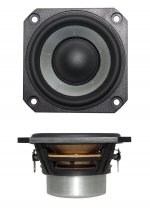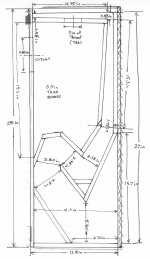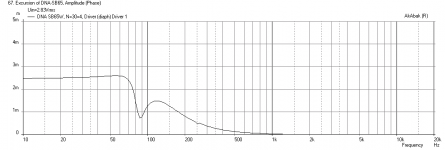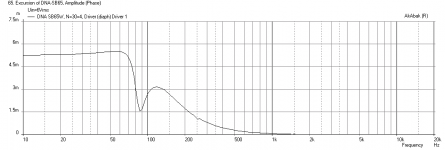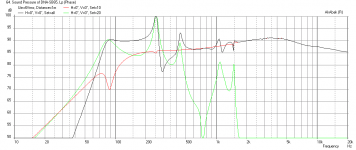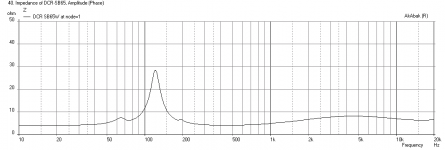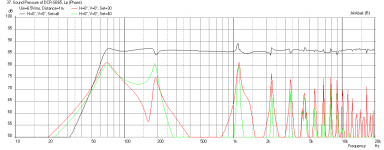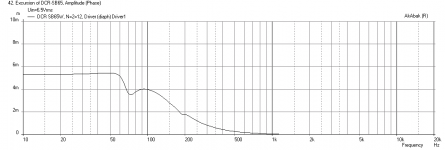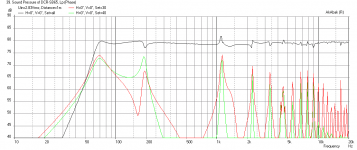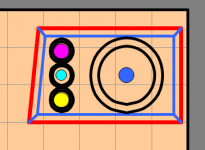I now have a pair of these really cute 2.5in drivers - they seem to have some nice specifications on paper. They look very well made and superb fit and finish - I am impressed by the quality from SB Acouatics. I have heard some great recommendations of this little guy - great HF extension almost aluminum dome tweeter like. Oh wait, it is about the size of an aluminum dome tweeter. 🙂
The neat thing is that with an xmax of 5.3mm and a moderate Qts, it can reach sub 100Hz in the right enclosure. Sure, if I run this in a FAST XO at 400Hz it would work very well. But given the huge xmax, I want to see what creative uses we can all come up with. Does anyone have experiences of good boxes that they have tried?
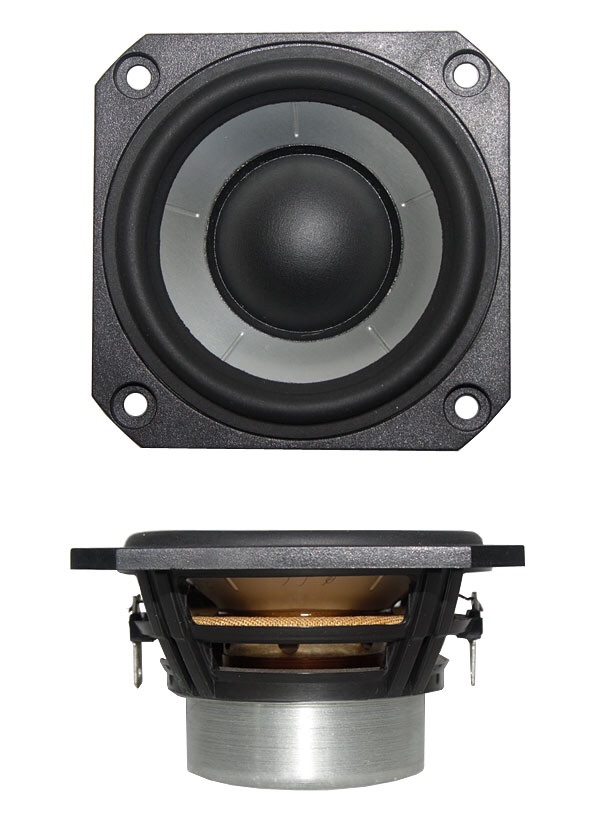
SB Acoustics :: 2 1/2" SB65WBAC25-4
My first thought is to make a small BLH for it. Maybe a hybrid BVR type BLH... Like a mini Decware DNA. 🙂
The neat thing is that with an xmax of 5.3mm and a moderate Qts, it can reach sub 100Hz in the right enclosure. Sure, if I run this in a FAST XO at 400Hz it would work very well. But given the huge xmax, I want to see what creative uses we can all come up with. Does anyone have experiences of good boxes that they have tried?

SB Acoustics :: 2 1/2" SB65WBAC25-4
My first thought is to make a small BLH for it. Maybe a hybrid BVR type BLH... Like a mini Decware DNA. 🙂
Attachments
Last edited:
xrk971,
Specs are nice...have you simmed anything yet? What about a mini-mini-Karlsonator? 🙂
Given the limited cone size, would the driver be able to go sufficiently loud while being pushed low? Maybe good for nearfield/DT usage? How about Labyrinth TLs?
BLH or BVR would be big? 🙂
Specs are nice...have you simmed anything yet? What about a mini-mini-Karlsonator? 🙂
Given the limited cone size, would the driver be able to go sufficiently loud while being pushed low? Maybe good for nearfield/DT usage? How about Labyrinth TLs?
BLH or BVR would be big? 🙂
Initial sims of DNA scaled to 0.5x look promising with 80Hz bass extension and no BSC necessary. 4in wide x 6in deep x 14in tall box.
DNA mini (0.45x scale) with SB65WBAC25-4
Before I describe the sim, I figured out how to memorize this driver's long name: SB 65 (mm nominal dia) Wide Band Aluminum Cone 25mm (voice coil) - 4 (ohms).
Ok, so if we take this design, nominally for a 5in driver, and cut the size down by about half and use it for a 2.5in driver that should be OK, right? Well, not quite and luckily for us, the DNA is not a true horn so the tuning frequency is set more by the chamber and vent size which forms part of the hybrid bass reflex part of the DNA, the other half being a rear facing "horn" that provides impedance matching of the BR duct to the environment.
Here is a rendering of the DNA (from website):

Here is my reverse engineered dimensions of the full scale DNA:
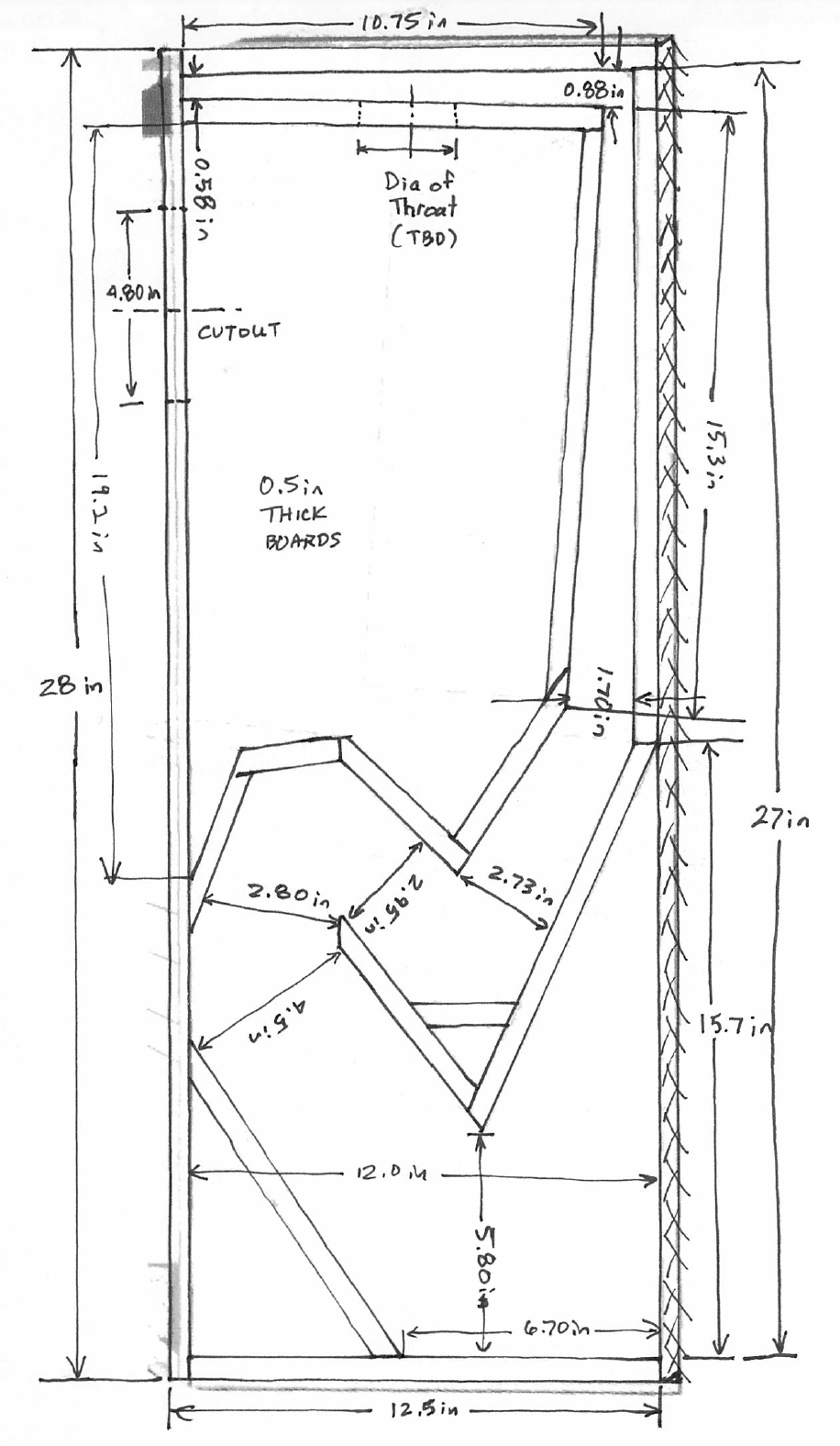
If we scale this drawing by 0.45x (easy to apply in the existing Akabak model). The true size is about 3.6in wide (internally) x 12.375in tall (externally) x 5.75in deep (externally). That is a tiny rear-firing hybrid-BR-horn speaker. Then add a 1.7in dia x 6in long vent tube between the driver chamber and the first segment of the horn. This is what you get in 4pi space with diffraction and reflection turned on but walls are far away. The sensitivity is not good but at least the bass levels are high enough to overcome baffle step losses:
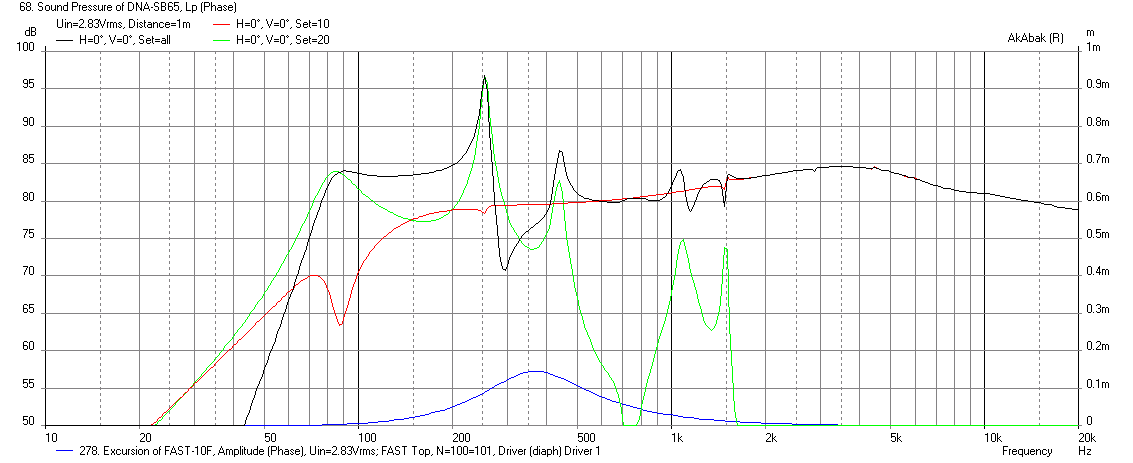
Here is the corresponding cone displacement at xmax:
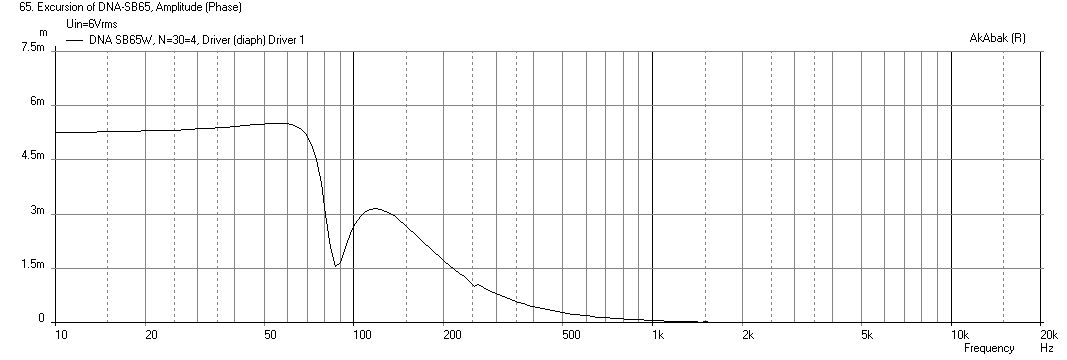
And this is the SPL output at xmax with 6v of drive:
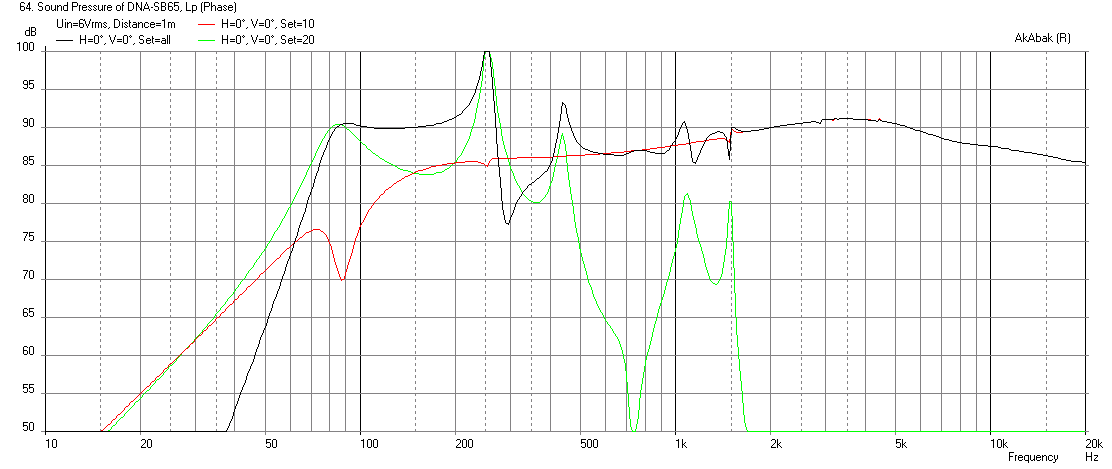
So it seems that it is really excursion limited and you won't get much SPL out of this. However, for near field use, probably OK. The result of using such a tiny driver to get bass is problematic as we can see. A better true horn loaded design will enable this to go to much higher SPL's.
Before I describe the sim, I figured out how to memorize this driver's long name: SB 65 (mm nominal dia) Wide Band Aluminum Cone 25mm (voice coil) - 4 (ohms).
Ok, so if we take this design, nominally for a 5in driver, and cut the size down by about half and use it for a 2.5in driver that should be OK, right? Well, not quite and luckily for us, the DNA is not a true horn so the tuning frequency is set more by the chamber and vent size which forms part of the hybrid bass reflex part of the DNA, the other half being a rear facing "horn" that provides impedance matching of the BR duct to the environment.
Here is a rendering of the DNA (from website):

Here is my reverse engineered dimensions of the full scale DNA:

If we scale this drawing by 0.45x (easy to apply in the existing Akabak model). The true size is about 3.6in wide (internally) x 12.375in tall (externally) x 5.75in deep (externally). That is a tiny rear-firing hybrid-BR-horn speaker. Then add a 1.7in dia x 6in long vent tube between the driver chamber and the first segment of the horn. This is what you get in 4pi space with diffraction and reflection turned on but walls are far away. The sensitivity is not good but at least the bass levels are high enough to overcome baffle step losses:

Here is the corresponding cone displacement at xmax:

And this is the SPL output at xmax with 6v of drive:

So it seems that it is really excursion limited and you won't get much SPL out of this. However, for near field use, probably OK. The result of using such a tiny driver to get bass is problematic as we can see. A better true horn loaded design will enable this to go to much higher SPL's.
Attachments
Last edited:
A Tiny 62Hz DCR?
This is a very easy build and certainly not as fancy as the mini DNA, but achieves a remarkably flat, albeit lower sensitivity system. For near-field monitors or PC soeakers, the lower sensitivity may not be an issue.
The box is 4in wide x 6in deep x 12in tall (quite small). The slot vents are 4in wide x 0.4in high x 4in long. The interchamber vent is 1.6in dia round tube that is 1.33in long. A BSC circuit was used to balance lows and highs as follows: 0.3mH + 4ohm + 3.3uF all in parallel. The result is truly an amazingly flat response. If the driver tracks this, it could be a mini monitor.
Here is predicted SPL at 2.83v and 1m away in 4pi space:
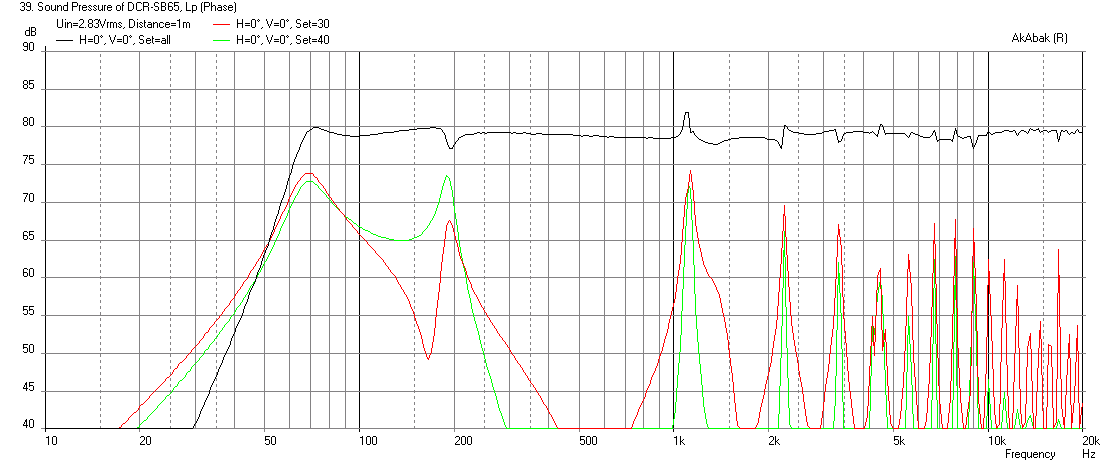
Here is corresponding cone displacement at xmax (5.3mm) reached with 6,5 volts of drive:
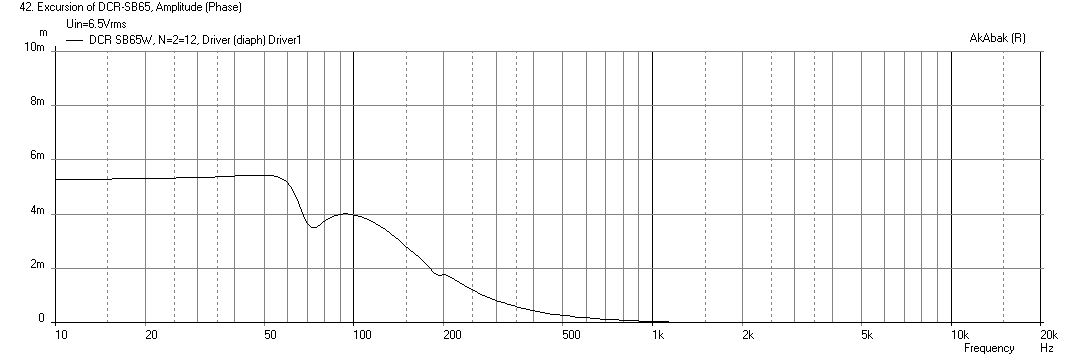
Here is corresponding max SPL:
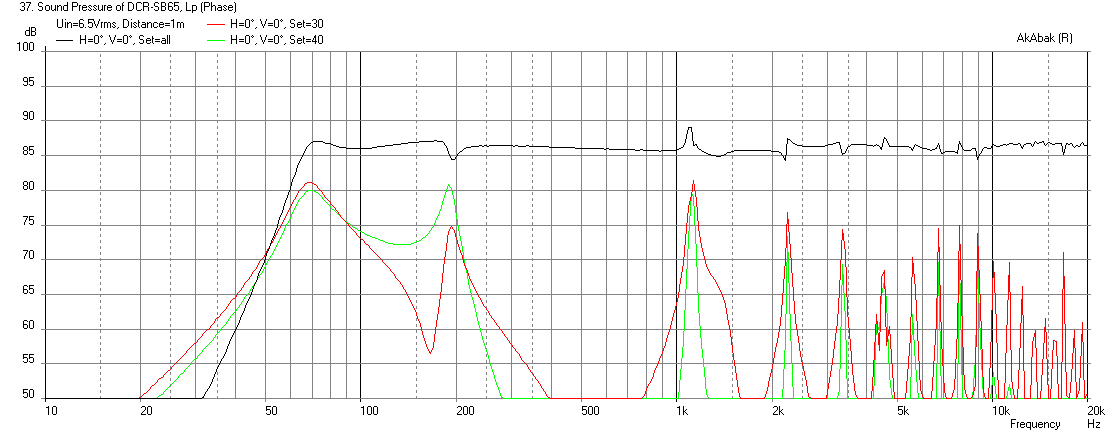
Here is Impedance of system:
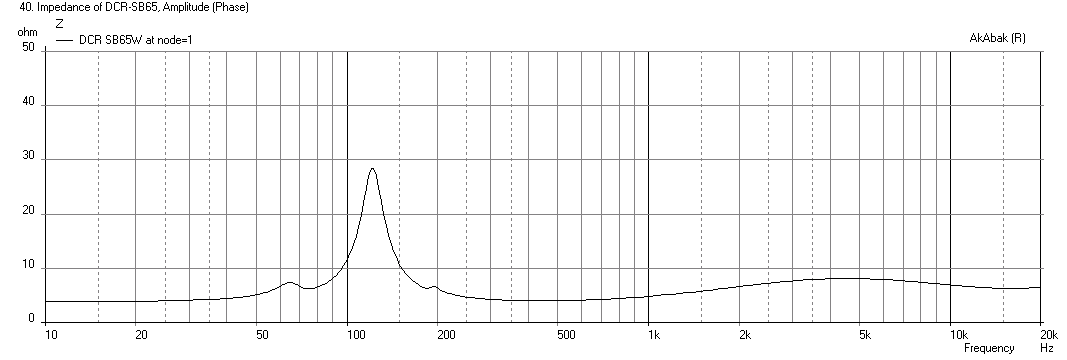
Note that higher SPL's can be achieved if high passed at say 55Hz.
This is a very easy build and certainly not as fancy as the mini DNA, but achieves a remarkably flat, albeit lower sensitivity system. For near-field monitors or PC soeakers, the lower sensitivity may not be an issue.
The box is 4in wide x 6in deep x 12in tall (quite small). The slot vents are 4in wide x 0.4in high x 4in long. The interchamber vent is 1.6in dia round tube that is 1.33in long. A BSC circuit was used to balance lows and highs as follows: 0.3mH + 4ohm + 3.3uF all in parallel. The result is truly an amazingly flat response. If the driver tracks this, it could be a mini monitor.
Here is predicted SPL at 2.83v and 1m away in 4pi space:

Here is corresponding cone displacement at xmax (5.3mm) reached with 6,5 volts of drive:

Here is corresponding max SPL:

Here is Impedance of system:

Note that higher SPL's can be achieved if high passed at say 55Hz.
Attachments
It appears SB specifies Xmax as a peak-to-peak value though, so it's more like 2.65mm, assuming symmetry of whatever factor they specify Xmax upon. Neat nevertheless, though the 4" to 5" range is more of a sweet spot for me when it comes to small FR drivers.
IG81,
Thanks for pointing the xmax out - in the case of 2.6mm it is like a TC9FD but not so sure any vented design makes sense given the low sensitivity. I might make it for grins but seems like this is best for a FAST high passed above fs. Probably where it shines is to act like a mid tweeter. The 1im aluminum dome dustcap probably sounds a lot like a good dome tweeter as it goes above 20kHz.
Thanks for pointing the xmax out - in the case of 2.6mm it is like a TC9FD but not so sure any vented design makes sense given the low sensitivity. I might make it for grins but seems like this is best for a FAST high passed above fs. Probably where it shines is to act like a mid tweeter. The 1im aluminum dome dustcap probably sounds a lot like a good dome tweeter as it goes above 20kHz.
Been there. I was looking at the SB16PFC25-08 for a simple 2-way design a while back and thought it was weird Xmax was 9mm for a 6", until I went back to the spec sheet and noticed the "(p-p)" I had missed the first time around. 🙂
I originally posted this over on the thread http://www.diyaudio.com/forums/full...-comparison-2in-4in-drivers-round-3-a-41.html, but I thought it would be worth reposting here....
I Decided to order the SB65WBAC25-4 after this listening test. It was my top pick (H), the measurements and specs are good and I have great experience with SBacoustics drivers in the past.
It arrived and I am very impressed!!
Tiny little thing, but it is definitely fullrange.
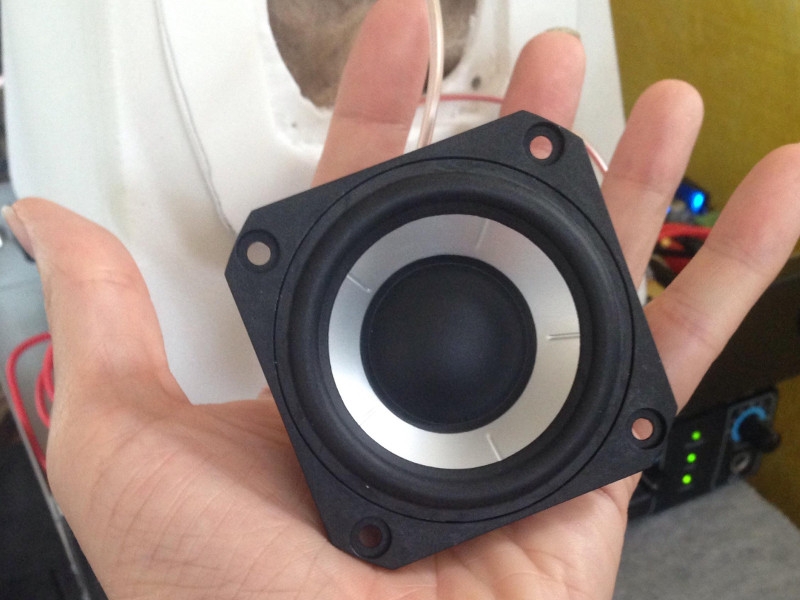
It is actually quite dynamic and has a delicate detailed treble like a dome tweeter. Even though this is just first impressions, but I think I like it better than the fe83en and ff105wk that I currently have (still waiting for EuropeAudio to ship my 10f/8424 grrr).
The SB65 really has a beautiful clarity and purity to them, but also have a surprising dynamic punch in the midbass. Almost sounds like a 3" or 4" driver but with a dome tweeter like clarity.
And mine actually measures even flatter than the one XRK shows here!
I made measurements here at 90db at 0.5m, which I think is higher than XRK's tests. At this level the drivers are quite loud. I am not sure how to measure the voltage (AC across the speaker terminals?). Maybe the voltage ranged from 1.3-1.8volts during the sweep. My measurements are fullrange and yes I did put 30hz into that little driver (poor thing), but the xmax on this thing is amazing (5.3mm p-p) for such a tiny driver.
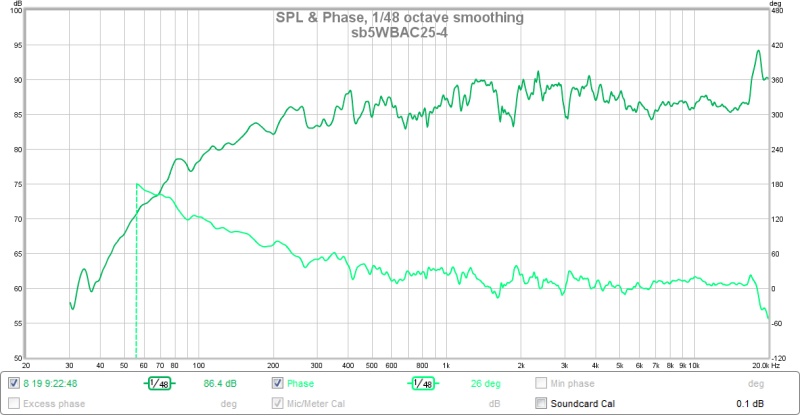
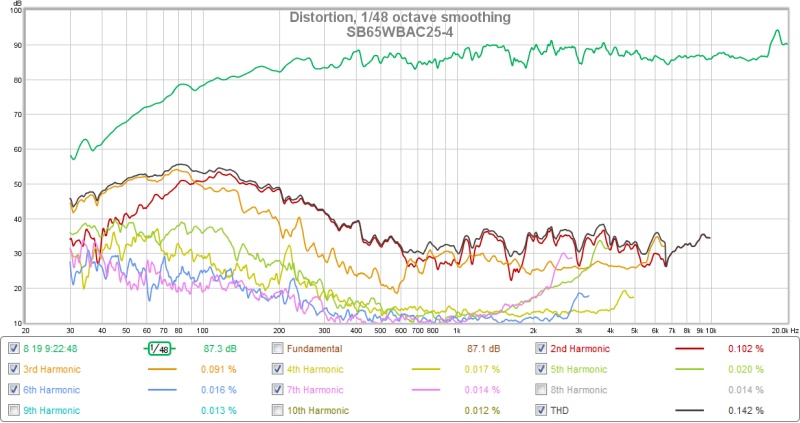
compared to XRK's measurement (with the 350hz XO to RS225)which I believe are at a lower output level than my measurements
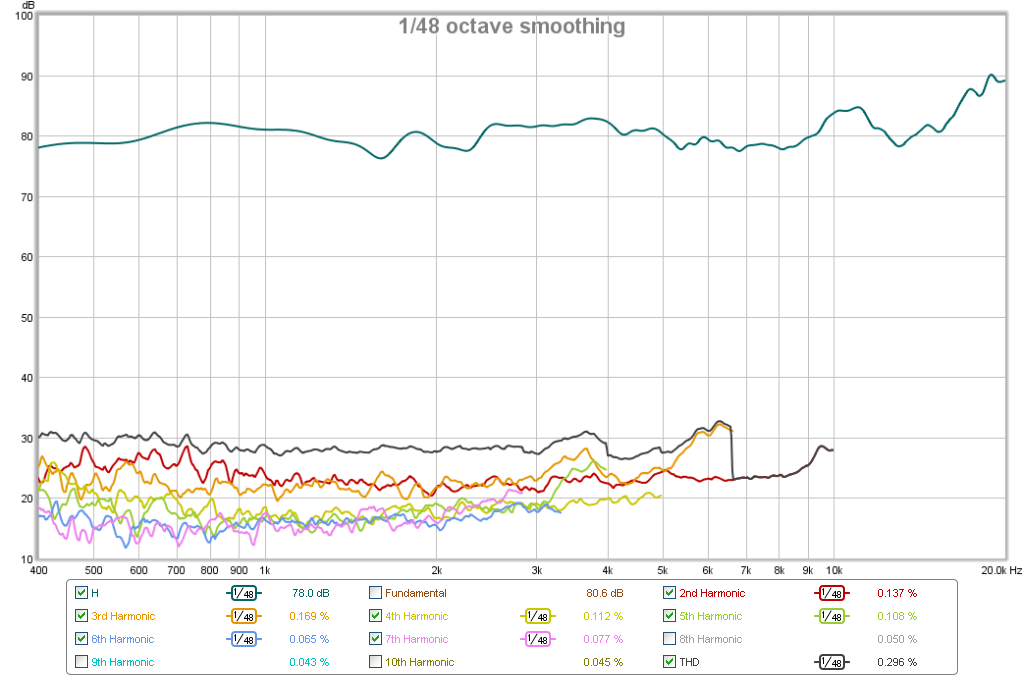
here is a measurement at 12cm when it first arrived, and fitting it to a target curve with a bass rolloff of 12db/oct at 145hz.
This is super flat with most of these bumps at 2-3db (no eq of course, just the raw driver in a sealed box)
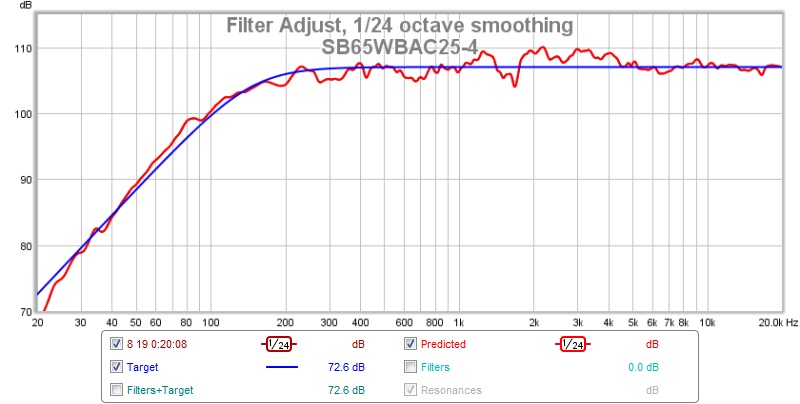
Unfortunately the local distributor only had 1 left, but when they get more, I am very tempted to pick up more (maybe do a small line array). But I should probably wait till the 10f arrive before I get too caught up in yet another driver purchase.
I need to wait for more drivers to get back in stock at the local distributor in Japan (shipping is almost too much for these little drivers from US or EU). But I am thinking about putting 2x or 3x into a line array on the edge of a slot-loaded open baffle woofer.
something like this but where the 20cm (8") woofer is not forward firing but a single pair is slot loaded. A folded W version of Nelson Pass's SLOB The Slot Loaded Open Baffle Project Article By Nelson Pass.
In Nelson's design he uses 6x 8" woofers in each slot but he is planning for these to be big room filling speakers. My aim is more a high quality, low distortion near-field monitor.
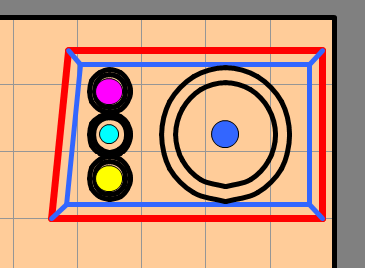
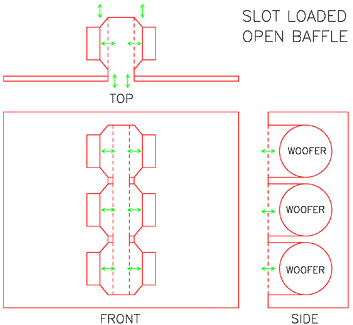
This would make a small (for OB) approximately 30cm x 40cm x 30cm open-backed box (folded OB) which could be used near-field or in a room. The reason I am leaning toward a small line-array is that the drivers max SPL does seem a bit limited if we want to keep distortion under control.
Something similar to this in basic design and end result http://www.atcloudspeakers.co.uk/professional/loudspeakers/scm25a-pro/ but with OB woofer and line array of mid/tweets (SB65) 🙂
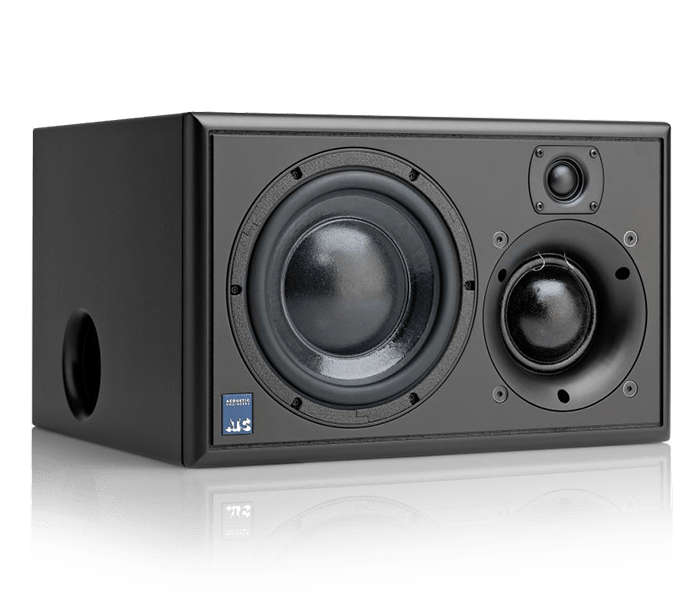
something like this but where the 20cm (8") woofer is not forward firing but a single pair is slot loaded. A folded W version of Nelson Pass's SLOB The Slot Loaded Open Baffle Project Article By Nelson Pass.
In Nelson's design he uses 6x 8" woofers in each slot but he is planning for these to be big room filling speakers. My aim is more a high quality, low distortion near-field monitor.


This would make a small (for OB) approximately 30cm x 40cm x 30cm open-backed box (folded OB) which could be used near-field or in a room. The reason I am leaning toward a small line-array is that the drivers max SPL does seem a bit limited if we want to keep distortion under control.
Something similar to this in basic design and end result http://www.atcloudspeakers.co.uk/professional/loudspeakers/scm25a-pro/ but with OB woofer and line array of mid/tweets (SB65) 🙂

Attachments
Last edited:
Neat idea for a small monitor using multiples. You will have a bit of comb filtering and lobing in vertical direction but may not be a big deal to you. What XO frequency were you planning on given the baffle edge diffraction you predict?
Yeah I suspected that the line-array would do that in the vertical, but the lobbing should be good. These sort of monitors are usually placed on a meter bridge or just above a music keyboard or other desk items, so there can be terrible reflections coming off all the irregular shapes directly below and in front of the monitor. Kind of like these sort of setups.
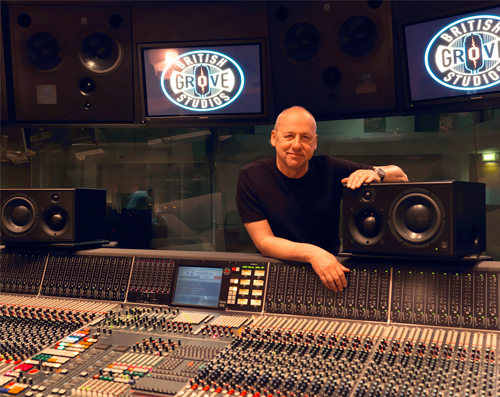

The comb effect, well... I hope with such small drivers and mounting them end-to-end (64mm center-to-center), it might minimize the effect. Ideally I would put a 30cm long linear ESL on the side of the box (like a mini version of my acoustat 1+1), but the thought of DIY building an ESL panel is just a bit too much for me at this point. I think a 2x or 3x line array of small drivers might get close enough.
I am not sure about the crossover yet. I need to see the response and distortion on the slot-loaded woofer and what the measurements of a line array of SB65 looks like. I could see it being anything from 200-500hz depending on the performance of the drivers. My first step is to build the SLOB woofer while waiting for more SB65 to come back in stock.


The comb effect, well... I hope with such small drivers and mounting them end-to-end (64mm center-to-center), it might minimize the effect. Ideally I would put a 30cm long linear ESL on the side of the box (like a mini version of my acoustat 1+1), but the thought of DIY building an ESL panel is just a bit too much for me at this point. I think a 2x or 3x line array of small drivers might get close enough.
I am not sure about the crossover yet. I need to see the response and distortion on the slot-loaded woofer and what the measurements of a line array of SB65 looks like. I could see it being anything from 200-500hz depending on the performance of the drivers. My first step is to build the SLOB woofer while waiting for more SB65 to come back in stock.
XRK do you know how to simulate a 3x line array of sb65 drivers? Is there free software for this?
I guess I am most interested in simulating the combing and lobbing effects to predict minimum listening distance and off axis response.
I known with PA line arrays for events that they follow a de-curve and are not flat. It also looks like the curve is not radial but an increasing curve. I wonder if with such a small array needs to curve though.
I still need to learn a lot more about line arrays
Sent from my K00R using Tapatalk
I guess I am most interested in simulating the combing and lobbing effects to predict minimum listening distance and off axis response.
I known with PA line arrays for events that they follow a de-curve and are not flat. It also looks like the curve is not radial but an increasing curve. I wonder if with such a small array needs to curve though.
I still need to learn a lot more about line arrays
Sent from my K00R using Tapatalk
XRK do you know how to simulate a 3x line array of sb65 drivers? Is there free software for this?
I guess I am most interested in simulating the combing and lobbing effects to predict minimum listening distance and off axis response.
I known with PA line arrays for events that they follow a de-curve and are not flat. It also looks like the curve is not radial but an increasing curve. I wonder if with such a small array needs to curve though.
I still need to learn a lot more about line arrays
Sent from my K00R using Tapatalk
Yes, you can model it with my software of choice: Akabak. I have modeled the 25 driver IDS-25 with TC9FD's below. You can see the comb effect at various drivers. You will need an archaic Windows machine (pre 64 bit) - XP or W2K. The software has a learning curve but start small and work your way up in complexity. It's a script programming language that uses JIT compilation. There is some window dialog automation but not a whole lot. I can get you the script for the 25 driver array. To model your OB with 3 drivers is pretty simple. I think you have a trapezoidal baffle so that can be simulated with a different baffle width for each driver position. It will give you pretty close results. I have also modeled the SLOB with Akabak as well.
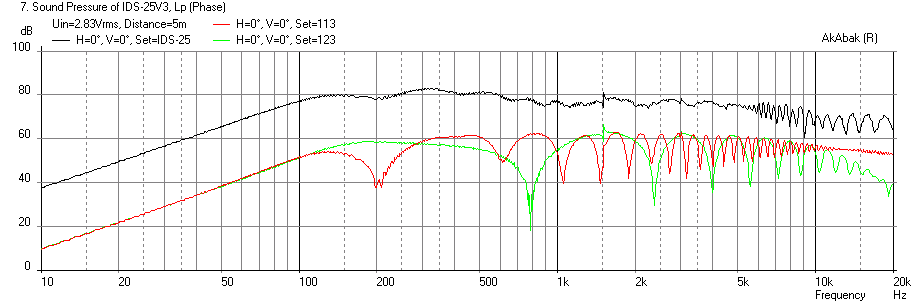
Model of 25 driver line array here:
http://www.diyaudio.com/forums/full-range/203356-cloning-ids-25s-20.html#post3631354
Akabak here:
http://www.randteam.de/AkAbak/Index.html
Akabak for Dummies:
http://www.avsforum.com/forum/155-d...k-dummies.html#/forumsite/3207/topics/1258118
Good tutorial by Don Hills:
http://www.diyaudio.com/forums/multi-way/90362-akabak-simulator-2.html#post1840180
Most of the basic guides will not get into the fine points of modeling an OB and how to handle edge diffraction and placement of drivers on baffle. But I can help you there.
Last edited:
On a SB65 in a closed box performance see:
SB Acoustics SB65WBAC25-4 2.5" full range
A volume of 0.5 to one liter provides an F3 to about 140 Hz.
My BassBox models give similar results.
SB Acoustics SB65WBAC25-4 2.5" full range
A volume of 0.5 to one liter provides an F3 to about 140 Hz.
My BassBox models give similar results.
How do these sound compared to the alpair 5.2 (which I can't find measurements for anywhere). Fatiguing? What's a realistic vented f3?
It sounds very neutral not fatiguing. It was one of the drivers in the Subjective Blind listening test threads and did very well. I don’t know what an A5 sounds like, but you can compare to an A7 in the listening tests.
Subjective Comparison Threads
A Subjective Blind Comparison of 3in to 5in Full Range Drivers
A Subjective Blind Comparison of 3in to 5in drivers - Round 2
A Subjective Blind Comparison of 2in to 4in drivers - Round 3
A Subjective Blind Comparison of 2in to 4in drivers - Round 4
A Subjective Blind Comparison of 2in to 3.5in drivers - Round 5
Subjective Comparison Threads
A Subjective Blind Comparison of 3in to 5in Full Range Drivers
A Subjective Blind Comparison of 3in to 5in drivers - Round 2
A Subjective Blind Comparison of 2in to 4in drivers - Round 3
A Subjective Blind Comparison of 2in to 4in drivers - Round 4
A Subjective Blind Comparison of 2in to 3.5in drivers - Round 5
Thanks for the reply. I think I will get a pair for some mini monitors. There are quite a few measurements showing that they don't have much nastiness up top, at least as far as I can hear. Measurements of the alpair 5.2 by comparison are few and far between.
It looks like ported is the main option for the mini sb driver, but an f3 in the 80 hz range is good considering.
It looks like ported is the main option for the mini sb driver, but an f3 in the 80 hz range is good considering.
I really would not use them to make any bass below 150Hz - they will distort since they are tiny. Bass requires volume of air to flow. Use a subwoofer and these as satellites or in a FAST to really use them to their potential. Although of you use them at low volumes like below 80dB maybe they are fine for 80Hz.
- Home
- Loudspeakers
- Full Range
- SB Acoustics SB65WBAC25-4 - What to do?
